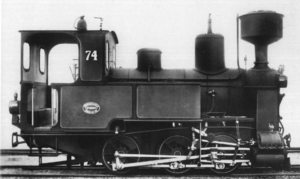ZTE 73 and 74
| ZTE 73 and 74 | |
|---|---|
|
Factory photo
|
|
| Numbering: |
ZTE 73 and 74 from April 1, 1897: SEG 73 and 74 on Jan. 1, 1953: MEG 74 |
| Number: | 2 |
| Manufacturer: | Krauss |
| Year of construction (s): | 1889 |
| Retirement: | until 1967 |
| Type : | C n2t |
| Gauge : | 1000 mm ( meter gauge ) |
| Length over coupling: | 6,600 mm |
| Length: | 5,560 mm |
| Height: | 3,700 mm |
| Width: | 2,400 mm |
| Total wheelbase: | 2,300 mm |
| Service mass: | 21 t |
| Friction mass: | 21 t |
| Wheel set mass : | 7 t |
| Top speed: | 25 km / h |
| Starting tractive effort: | 29.7 kN |
| Driving wheel diameter: | 910 mm |
| Control type : | Allan |
| Cylinder diameter: | 300 mm |
| Piston stroke: | 500 mm |
| Boiler overpressure: | 12 bar |
| Grate area: | 0.82 m² |
| Evaporation heating surface: | 46.8 m² |
| Water supply: | 3 m³ |
| Fuel supply: | 1 m³ |
| Brake: |
Körting suction air brake , hand brake |
The meter-gauge ZTE 73 and 74 steam locomotives were built by the Krauss locomotive factory for the Baden Railway Consortium as the owner of the Zell-Todtnauer Local Railway (ZT). They entered service in 1889 when the line opened. Locomotive 74 was in use for over 70 years until it was shut down and is preserved as an exhibit in the Bochum Railway Museum.
History and commitment
The locomotives were ordered by the Baden Railway Consortium, in which Herrmann Bachstein was involved, and were in operation on the Zell – Todtnau railway line from the opening. On April 1, 1897, the railway was transferred to the Süddeutsche Eisenbahn-Gesellschaft (SEG). From this point on, the locomotives were referred to as SEG 73 and 74 .
At the beginning, the two locomotives were sufficient for all traffic. When the train loads increased, they were only used in passenger transport from the end of the 1890s. The tensile loads were given on the section Zell - Schönau with 24 axles, on the section Schönau - Todtnau with 14 axles at a speed of 20 km / h.
In 1910, the SEG 73 locomotive had an accident while clearing snow when it derailed and fell into the meadow . During the repair, which took almost a year, the appearance of the locomotive changed. So the originally open cab got doors. The SEG 73 had to be handed in for military service in 1940 and did not return to its original route afterwards.
From the Second World War, only the SEG 74 drove on the route. In the early 1950s she had a collision with a truck at an open level crossing.
MEG 74
From January 1, 1953, the line belonged to the Mittelbadische Eisenbahn-Gesellschaft (MEG) and the locomotive was given the road number MEG 74 .
After the MEG T 15 railcar was put into service in 1955, it only operated temporary passenger trains or was responsible for special services.
When the line was discontinued in 1967, the locomotive was still there and was sold to the German Society for Railway History and first exhibited in the DGEG Railway Museum Neustadt / Weinstrasse . In 1972 it was housed in the then newly opened narrow-gauge museum in Viernheim . In 1989, after the Viernheim Museum was closed, the locomotive was transported to Bruchhausen-Vilsen on a low-loader and stored, but it was not sold to the German Railway Association . The locomotive was then passed on to the Bochum Railway Museum. It is exhibited under one roof in the outdoor area.
technology
The locomotive has an inner frame with a water tank riveted into the frame cheeks and two smaller outer water tanks on both sides of the boiler. On the left in front of the driver's cab there is a coal box for 1 m³ of fuel. The iron cauldron has a copper fire box . The stud bolts are also made of copper in the lower area, the top two rows are made of iron. The locomotive's wheels are wrought-iron spoked wheels. Axles, bandages, piston rods, crosshead and springs of the locomotive are made of the best quality steel, while all bolts of the control mechanism and the crank pins are made of fine-grain iron.
The locomotive has an Allan control. The slide valves sit at an angle on the steam cylinder. As a new building, it had a Kobel chimney, a bell on the open driver's cab and kerosene lighting. In later renovations, the driver's cab was given doors, the Kobel chimney was replaced by a standard chimney, the bell was placed behind the chimney, and electrical lighting was installed. The alternator for this was placed on the top of the boiler between the steam and sand dome.
literature
- Ludger Kenning, Michael Kopfmann: Narrow gauge railway Zell-Todtnau . Verlag Kenning, Nordhorn 2003, ISBN 3-933613-49-3 , p. 50-53 .
Web links
- Data sheet about the Zell-Todtnauer Bahn with mention of the SEG 73-74
- Website about the Bochum Railway Museum with a mention of the MEG 74 that has been preserved
- Photograph by SEG 74, 1959 on eisenbahnstiftung.de
- Photograph of the SEG 74 1967 on eisenbahnstiftung.de
Individual evidence
- ^ A b Ludger Kenning, Michael Kopfmann: Narrow-gauge railway Zell-Todtnau . Verlag Kenning, Nordhorn 2003, ISBN 3-933613-49-3 , p. 50 .
- ↑ Ludger Kenning, Michael head man: Schmalspurbahn cell Todtnau . Verlag Kenning, Nordhorn 2003, ISBN 3-933613-49-3 , p. 18 .
- ↑ Ludger Kenning, Michael head man: Schmalspurbahn cell Todtnau . Verlag Kenning, Nordhorn 2003, ISBN 3-933613-49-3 , p. 32 .

